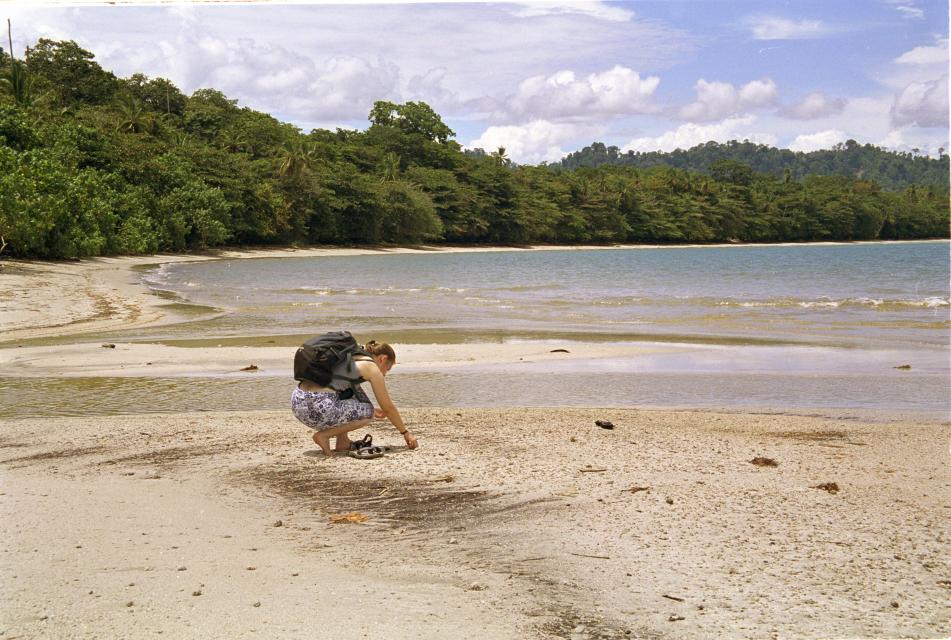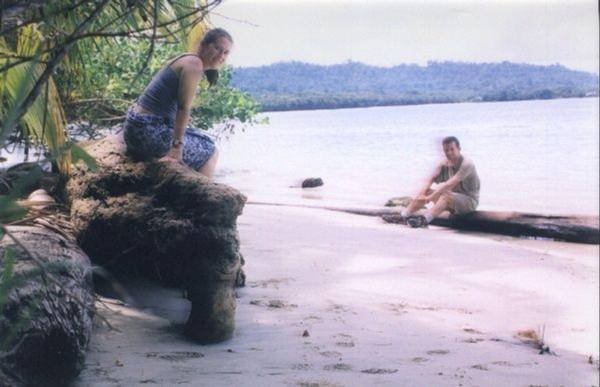4 October 2002: San José, Costa Rica
Subject: Costa Rica
Some time has passed since I last wrote anything - I hope you have all been able to stand the suspense! Now at last you can read something about what I've been doing in Costa Rica.
A few days after I got here, my sister Christine arrived from home to join me for the next few countries. She has given up her job and left her chickens and poly-tunnel in the hands of a house-sitter to see Costa Rica and South America. Needless to say it is great to have some company for a change!
San José
San José is Costa Rica's capital; not a big city by world standards, but busy and noisy enough. Costa Rica is supposed to be the most affluent central american country and there is plenty of evidence of this here: bars over windows and private security guards in all the shops, people living in cardboard boxes on the streets, big cars driving around belching out filthy smoke, piles of rubbish on every street corner, and drivers talking into their mobile phones as they negotiate junctions. But despite all this it has some attractions worth coming for: mostly the museums.
Although the pre-conquest civilisations here didn't leave the sort of spectacular architectural monuments that they did in Mexico and Peru, there were still plenty of people here and they clearly had a developed culture. The National Museum has an excellent collection of artefacts all the way from pre-conquest things, through the colonial era and the coffee/banana producing times, to Oscar Arias Sanchez's Nobel peace prize certificate and medal. (Interestingly, Intel's fab here is now the bigest foreign exchange earner, so the coffee/banana era can be said to be over.)
Then two other museums, the Jade Museum and the Pre-Columbian Gold Museum focus purely on the pre-conquest artifacts. These include quorn-like grinding tables, carved from single pieces of volcanic stone, and intricately decorated on the underside. Often these things were buried as grave-goods. Then there was some fabulous pottery, with polychromatic decoration and often with animal or other features stuck on. I didn't get very excited by the jade, but the gold items were great: mostly they were small cast animal figures that could be pendants or attached to clothing. In some cases they were clearly designed to flash in the light and maybe jingle in the breeze as they included bells and tiny flat mirror plates. The animals included birds, jaguars, and cutest of all frogs and bats. We both wanted to take one home! You can see pictures of some of the artefacts at http://www.mcguinnessonline.com/gold/.
Volcán Poás
From San José we went on a day trip by bus to Volcán Poás, a gently-steaming volcano with a lake in its crater. It's a short walk from the car park up to the edge of the crater, and when we arrived there was no view at all. But after a short walk in the cloud forest (not very exciting - it reminded us both of walking through rodedendrons) we went back and the cloud had lifted. The crater is huge - a mile across! The lake in the bottom has changed size depending on the heat coming from the magma, and boiled away to next-to-nothing (only boiling pools of sulphur) a few years ago. The visitors' centre had an excellent technical thing about it all done by people from the Open University! Here's a view into the crater and its lake.

Cahuita
We'd had quite enough of San José by the time we left, and we found somewhere much quieter to move on to. Rather than being kept awake by the traffic, it was the Caribean waves crashing against the shore that we could hear! Cahuita is on Costa Rica's east coast, not too far from the Panamanian border. Here's a . But first we had to get there, and the bus journey from San José is great. In the late 70s they decided that the needed a new road to link the capital with the Caribean coast - until then there was "only" a railway. The most obvious route was through a big chunk of unexploited jungle, and the road was built in exchange for the jungle being protected as the Braulio Carrillo national park. (In the 1991 earthquake the railway was damaged, and hasn't been repared, so this two-lanes-up, one-lane-down road is now the only route through the mountains.) From the bus windows you can look out over the tops of the trees in the valley below - almost an aerial view. On the uphill side you can see the huge ferns, gunneras and trees, and an occassional stream tumbling down. Sadly the bus doesn't stop at any of the viewpoints; I suppose all the locals have seen it all before.
So we arrived in Cahuita in the heat of the afternoon: hot, but not too hot and not raining as it had done every afternoon in San José. Unlike the entirely-hispanic population in the rest of the country, this area is more like the Caribean islands with english-speaking people, including a few real Rastas. We stayed in a place right on the shore with our view of the sea interrupted only by palm trees and the hammocks hung from them!
Just to the south of the village is a national park protecting a swathe of jungle, two lovely beaches and a coral reef. We got to see all of them. All national parks in Costa Rica have a US$6 admission charge, but according to the guide book when the authorities proposed increasing it to US$15 the locals in Cahuita had a mini-revolution and replaced the national park entrance station with their own operation, asking people to pay what they want. Quite rightly they thought that tourists would rather stay somewhere else than pay US$15 each per day to sit on their beach! Even so I think it is still the first time that I've ever had to pay to go to the beach. And then at 5 in the afternoon they close and kick you out, just as the sun is getting low enough for us pale-skinned north Europeans to venture out. Anyway it is very pretty and certainly worth paying the admission fee at least once.

Christine is better than me at spotting creatures and we got to see all sorts of things as we walked along the path beind the first beach, around the headland and down to the second one. We saw two sorts of monkeys: first Howler Monkeys, which you hear before you see, and then the smaller white-faced Capuchin Monkeys. We saw a lot of Capuchins as we met a guided group; the monkeys are habituated to congrugating around the groups to be fed pineapples. They seem to nibble a bit and drop the rest, which means you can pick it up and offer it to them again.

We saw a few sloths: there are probably lots of them in the trees but because they don't move around and blend in quite well they are hard to spot. Again we saw them because we met guided groups; the guides were trying to make them move around by whistling and hooting at them.

The most numerous creatures were the crabs, of which we saw five kinds: ordinary crabs living on the rocks, lots of hermit crabs, ghost crabs living in holes in the sand, and lovely red and black land crabs living down holes in the jungle. The fifth kind we saw only one of in a stream, but it was so big that for a moment we though it was a baby turtle! The crabs tend to scuttle away as you approach; if you hear a scuttling noise it's either a crab or a lizard. We saw at least two sorts of lizards, a few chameleons and two sorts of gecko: back at our cabin we could watch geckos catching insects around the outside lights. To round off the reptiles Christine saw two snakes, but I wasn't observant enough.
The insect kingdom was well represented too (Costa Rica is supposed to have 350,000 species of insects!). We saw leaf-cutter ants carrying their bits of leaf back to the nest, and several other kinds. We saw a few dragonflies and butterflies, most impressive being the huge Morpho Blue, which is brown on the underside but bright blue on top, so you see blue flashes as it flutters along. We saw a cicada (normally heard but not seen) and I won't mention insects of the biting kind.
There were birds too, and a few bats. I'm not great at birds but I didn't have any trouble identifying the Yellow-Crowned Night Heron from a crib-sheet. He stood very still as I walked past. There are plenty of vultures and some sort of sandpiper that runs in and out of the surf. And we saw a few hummingbirds outside the cabin.
On the rocky shore we saw lots of Chitons - primitive things that look like two-inch-long woodlice stuck in holes on the rocks. There were also a few sea urchins and anenomes, just like rock pools at home. In the sand we found lots of Sand Dollars - like flat sea urchins.
Then there was our "mystery mammal", which we decided in the end was an Agouti. Actually Christine knew it was an agouti straight away, but the locals had about four different names for it. It's a sort of giant rodent thing.
Then we went snorkelling, and probably saw as many species of fish as we'd seen species of everything else put together! We went out in a boat to a bit of reef a few hundred metres from the headland; I had never snorkelled before and was breathing a mixture of air and sea water, which didn't make things easy, but still we saw all sorts of brightly-coloured fish, sometimes outrageously so like the inch-long black fish with luminous blue spots on. So if you're the sort who likes to tick off species in your field guide, it's a pretty good place to come.
Cahuita is also where I discovered how to get a good price for a room. We went snorkelling with the couple from the neighbouring room. They were Dutch and he told me that he worked for a pharmaceuticals company and travelled a lot on business. But it seems that he told the hotel people that he lived in Costa Rica and owned a restraunt on the Pacific coast, and had recommended that place to his guests! That got him his room for US$1.50 a night less than we paid, even though we stayed five nights rather than two. I hear that in some countries it is normal to haggle to get the price down, but if you have to go to those lengths I don't think I want to.
Here's a nice picture of the two of each on Cahuita's beach:

So now we're back in San José briefly before moving on; next we're going North to Ciudad Quesada, from where we can go to the Caño Negro wetlands and to Arenal Volcano. And I might even get to go down a cave! More news later.